2005 FELLOWS
Duane S. Boning
For contributions to
modeling and control in semiconductor manufacturing
Duane S. Boning is Professor of Electrical
Engineering and Computer Science
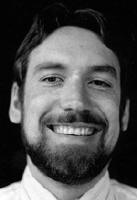 at
MIT. His degrees are also from MIT; he holds S.B. degrees in both
computer science and electrical engineering, and earned the Ph.D.
degree in 1991. His research focuses on interconnect technology,
variation modeling, control, and environmental issues in
semiconductor and MEMS manufacturing with emphasis on chemical
mechanical polishing and plasma etch, and CAD tools for statistical
process, device, and circuit design. From 1991 to 1993 he was a Member
of the Technical Staff at Texas Instruments in Dallas, where he worked
on process/device simulation tool integration, semiconductor process
representation, and statistical modeling and optimization. He has over
120 papers and conference presentations in these areas of research. at
MIT. His degrees are also from MIT; he holds S.B. degrees in both
computer science and electrical engineering, and earned the Ph.D.
degree in 1991. His research focuses on interconnect technology,
variation modeling, control, and environmental issues in
semiconductor and MEMS manufacturing with emphasis on chemical
mechanical polishing and plasma etch, and CAD tools for statistical
process, device, and circuit design. From 1991 to 1993 he was a Member
of the Technical Staff at Texas Instruments in Dallas, where he worked
on process/device simulation tool integration, semiconductor process
representation, and statistical modeling and optimization. He has over
120 papers and conference presentations in these areas of research.
Prof. Boning is currently Associate Head for
Electrical Engineering in the EECS Department at MIT. He was Associate
Director of the MIT Microsystems Technology Laboratories from 1998 to
2004, and also served as Co-Director for Undergraduate Education in
the Cambridge-MIT Institute, where he was active in undergraduate
exchange programs and establishment of new educational research
efforts. He has also been active in the MIT Leaders for Manufacturing
Program (LFM), as well as the manufacturing program of the
Singapore-MIT Alliance. He is Editor in Chief of the IEEE Transactions
on Semiconductor Manufacturing, and has been active in the IEEE
International Interconnect Technology Conference and other workshops
and meetings.
|
Joseph Paul Campbell
For leadership in
biometrics, speech systems, and government applications
Joseph P.
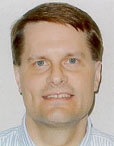 CAMPBELL,
Jr. (S'78, M'79, S'79, M'86, S'90, M'92, SM'97, F'05) received B.S.,
M.S., and Ph.D. degrees in electrical engineering from Rensselaer
Polytechnic Institute in 1979, The Johns Hopkins University in 1986,
and Oklahoma State University in 1992, respectively. Joe is currently
a Senior Member of the Technical Staff at MIT Lincoln Laboratory in
the Information Systems Technology Group, where he conducts
speech-processing research and specializes in advanced speaker
recognition methods. Joe's current foci are high-level features for
and forensic-style applications of speaker recognition, creating
corpora to support speech processing research and evaluation, robust
speech coding, biometrics, and cognitive radio. Before joining
Lincoln, he served 22 years at the National Security Agency (NSA). CAMPBELL,
Jr. (S'78, M'79, S'79, M'86, S'90, M'92, SM'97, F'05) received B.S.,
M.S., and Ph.D. degrees in electrical engineering from Rensselaer
Polytechnic Institute in 1979, The Johns Hopkins University in 1986,
and Oklahoma State University in 1992, respectively. Joe is currently
a Senior Member of the Technical Staff at MIT Lincoln Laboratory in
the Information Systems Technology Group, where he conducts
speech-processing research and specializes in advanced speaker
recognition methods. Joe's current foci are high-level features for
and forensic-style applications of speaker recognition, creating
corpora to support speech processing research and evaluation, robust
speech coding, biometrics, and cognitive radio. Before joining
Lincoln, he served 22 years at the National Security Agency (NSA).
From 1979 to 1990, Dr. Campbell was a member of
NSA's Narrowband Secure Voice Technology research group. Joe and his
teammates developed the first DSP-chip software modem and LPC-10e,
which enhanced the Federal Standard 1015 voice coder and improved US
and NATO secure voice systems.
He was the Principal Investigator and led the US
Government's speech coding team in developing the CELP voice coder,
which became Federal Standard 1016 and is the foundation of digital
cellular and voice over the Internet telephony systems. From 1991 to
1998, Dr. Campbell was a senior scientist in NSA's Biometric
Technology research group, where he led voice verification research.
From 1994 to 1998, Joe chaired the
Biometric Consortium, the US Government's focal
point for research, development, test, evaluation, and application of
biometric-based personal identification and verification technology.
From 1998 to 2001,
He led the Acoustics Section of NSA’s Speech
Research branch, conducting and coordinating research on and
evaluation of speaker recognition, language identification, gender
identification, and speech activity detection methods.
From 1991 to 1999, Dr. Campbell was an Associate
Editor of the "IEEE Transactions on Speech and Audio Processing." He
was an IEEE Signal Processing Society Distinguished Lecturer in 2001.
From 1991 to 2001. From 1991 to 2001, Joe taught Speech Processing at
the Johns Hopkins University. Dr. Campbell is currently a member of
the IEEE Signal Processing Society’s Board of Governors and Long Range
Planning Committee; an Editor in Chief of “Digital Signal Process”
journal; a Chair of the International Speech Communication
Association’s Speaker and Language Characterization Special Interest
Group (ISCA spLC SIG); a member of ISCA, Sigma Xi, and the Acoustical
Society of America; and a Fellow of IEEE.
|
Clifton G. Fonstad
For leadership in compound
semiconductor heterostructure devices
Clifton G. Fonstad received his BS degree in 1965
from the University of Wisconsin,
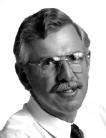 Madison,
and his MS and Ph.D. degrees in 1966 and 1970, respectively, from the
Massachusetts Institute of Technology (MIT). He has been a faculty
member at MIT since receiving his Ph.D., and teaches undergraduate and
graduate courses in semiconductor devices and technology. He is
currently the Vitesse Professor of Electrical Engineering and Computer
Science. Madison,
and his MS and Ph.D. degrees in 1966 and 1970, respectively, from the
Massachusetts Institute of Technology (MIT). He has been a faculty
member at MIT since receiving his Ph.D., and teaches undergraduate and
graduate courses in semiconductor devices and technology. He is
currently the Vitesse Professor of Electrical Engineering and Computer
Science.
Professor Fonstad directs an active graduate student
research group focused on monolithically integrating III-V
functionality with silicon electronic circuits using their RM3
integration concept (recess mounting with monolithic metallization).
The group is currently developing OptoPill Assembly, the newest RM3
process, and using it to realize optoelectronic integrated circuits
for a variety of applications, including optical clock and signal
distribution on Si ICs, diffuse optical tomography on living tissue,
and parallel signal processing in optically coupled neural network
arrays. The group is also concerned with the MBE-growth of III-V
heterostructures and their application in a variety of advanced
electronic and optoelectronic devices, including p-i-n photodiodes,
quantum-well laser diodes, and microscale thermophotovoltaic cells.
With his students and collaborators, Professor
Fonstad has published over 150 articles in refereed technical
journals; he is also the author of "Microelectronic Devices and
Circuits," an undergraduate text on semiconductor device physics,
models, and applications. He is a member of the Electron Devices and
the Lasers and Electro-Optics Societies of the Institute of Electrical
and Electronics Engineers, and of the American Physical Society.
|
George L. Heiter
For contributions to
microwave circuits, including linear amplifiers and space diversity
combiners.
George L. Heiter
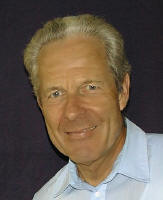 received
his “Vordiplom” and “Dipl. Ing.” degrees from the Universities of
Darmstadt and Karlsruhe/Germany, and his Ph.D. degree from Stanford
University in 1957, 1959 and 1964, respectively. received
his “Vordiplom” and “Dipl. Ing.” degrees from the Universities of
Darmstadt and Karlsruhe/Germany, and his Ph.D. degree from Stanford
University in 1957, 1959 and 1964, respectively.
He joined (then) Bell Telephone Laboratories in
1963, where he worked on high power ferrite materials and phase
shifters, acoustic delay line and optical memories, and long-distance
terrestrial microwave and hybrid fiber-coaxial (HFC) communication
systems. He has published and holds patents in most of these areas. In
1996 he joined Analog Devices, Inc., developing multifunction chips
for HFC and Digital Audio Broadcasting (DAB) systems and working on
Digital Subscriber Line (DSL) chip set applications. He retired in
December of 2001 and formed Heiter Microwave Consulting, specializing
in the design of communication systems.
Within the MTT, he has chaired the Microwave Prize
Awards Committee since 1991 and is an MTT representative to the
European Conference on Wireless Communications. He has been a member
of the Editorial Board of the Transactions, and a Guest Editor for
both technical Special Issues and the December Special Issues for the
International Microwave Symposia (IMS) in 2000, 2001 and 2002. For IMS,
he served on Technical Program Committees, and on separate Steering
Committees as Digest Editor, Transactions Editor and Publications
Chair. He has fostered interactions between MTT Technical Committees,
(co)-chaired the Committee on Microwave Systems (MTT-16) and is a
member of MTT-9 and MTT-20.
He is a member of the IEEE Electron Devices Society,
the American Physical Society and Sigma Xi.
|
James Joseph Komiak
For contributions to
monolithic microwave integrated circuits, high power amplifiers, and
transmit/receive modules
James J. Komiak received the Ph.D. degree in
Electrical Engineering from Cornell
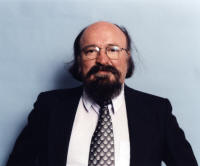 University
in 1978. His Ph.D. research was directed towards a novel broadband
matching technique for arbitrary loads using measured data directly,
the "Real Frequency Technique". University
in 1978. His Ph.D. research was directed towards a novel broadband
matching technique for arbitrary loads using measured data directly,
the "Real Frequency Technique".
Dr. Komiak is an Engineering Fellow in the Microwave
Electronics Group at BAE Systems. His current activities are in MMIC,
module, and sub-system design for EW, communication, and radar system
applications. Principally known for work in power, Dr. Komiak has
designed over 100 MMICs achieving state of the art results. Prior to
consolidation at Sanders and the subsequent sale to BAE Systems, Dr.
Komiak was with the Lockheed Martin/Martin Marietta/General Electric
Electronics Laboratory.
Dr. Komiak has been active with MTT-S and the IMS
TPC with MTT-5/SC-19 High Power Amplifier Components. He was with the
IEEE GaAs IC Symposium TPC and ExCom and was Symposium Chairman in
2000. He is also active as an Accreditation Board for Engineering &
Technology IEEE-sponsored University Electrical Engineering Program
Evaluator. He has 65 publications and 6 patents relating to circuit
theory, GaAs MMIC devices and technology, high power amplifiers,
solid-state apertures, and RF/microwave design. Dr. Komiak received
the 2001 BAE Systems Silver Chairman’s Award for Innovation for "Blue
Force Locator and Monitor", the 1993 Martin Marietta Jefferson Cup
Award for "Outstanding Technical Leadership in Development and
Demonstration of High Power and High Efficiency MMIC Amplifiers and
T/R Modules for Phased Array Radar", and his work is represented in
the MTT Symposium MMIC Historical Exhibit as "World's First Octave
Band MMIC with Power Output in Excess of 10 Watts (1989)".
|
Shu T. Lai
For contributions to
spacecraft interactions with space plasmas
Dr. Shu T. Lai,
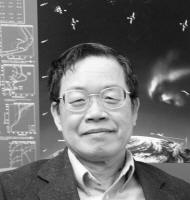 a
senior physicist in the Space Weather Center of Excellence, Space
Vehicles Directorate, Air Force Research Laboratory (AFRL), Hanscom
Air Force Base, Massachusetts, is a recognized leader in spacecraft
interactions with space plasmas. This area is important to space
science and engineering, systems, and missions. He was previously
with the Massachusetts Institute of Technology Lincoln Laboratory. a
senior physicist in the Space Weather Center of Excellence, Space
Vehicles Directorate, Air Force Research Laboratory (AFRL), Hanscom
Air Force Base, Massachusetts, is a recognized leader in spacecraft
interactions with space plasmas. This area is important to space
science and engineering, systems, and missions. He was previously
with the Massachusetts Institute of Technology Lincoln Laboratory.
With his theoretical formulations and data analysis
of spacecraft environmental interactions, Dr. Lai has contributed
significantly to the maturation of spacecraft charging from its
infancy in the late 1970s into its current state as a well-developed
aerospace subject that impacts spacecraft design, space experiments,
space electronics and spacecraft survivability. Dr. Lai’s more than
eighty publications, including three patents, communicate important
advances in understanding the process of spacecraft surface charging,
deep dielectric charging, mitigation techniques, critical velocity
ionization in the vicinity of spacecraft, and hypervelocity impacts on
spacecraft.
Dr. Lai received his Ph.D. in Physics from Brandeis
University, Waltham, MA, 1971 and the Certificate of Special Studies
in Administration and Management from Harvard University, Cambridge,
MA, 1986. He was the leading guest editor of IEEE Transactions on
Plasma Science, Special Issue on Space Plasmas, Dec 2000. He was the
Chair of the IEEE Nuclear and Plasma Chapter, IEEE New England
Section, 1993-1996. He has chaired numerous sessions in conferences
of IEEE, American Institute of Aeronautics and Astronautics (AIAA),
American Geophysical Union (AGU), American Physical Society (APS), and
in Spacecraft Charging Technology Conferences. He also served as the
Chair of the AIAA Atmospheric and Space Environments Standards
Committee, 1996-2002, and the Chair of the AIAA Atmospheric and Space
Environments Technical Committee, Jan 2003-Jan 2005. In addition to
his election to IEEE Fellow, Dr. Lai is also a Fellow of the Institute
of Physics, a Fellow of the Royal Astronomical Society, and an
Associate Fellow of AIAA.
|
Hanoch Lev-Ari
For contributions to
adaptive filtering and structured estimation for non-stationary
signals
Hanoch Lev-Ari received the B.Sc. (Summa Cum Laude)
in
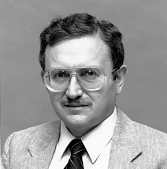 1971,
and the M.Sc. in 1978, both in electrical engineering from the
Technion, Israel Institute of Technology, Haifa, Israel; and the Ph.D.
in electrical engineering from Stanford University in 1984. 1971,
and the M.Sc. in 1978, both in electrical engineering from the
Technion, Israel Institute of Technology, Haifa, Israel; and the Ph.D.
in electrical engineering from Stanford University in 1984.
During 1985 he held a joint appointment as an
Adjunct Research Professor with the Naval Postgraduate School in
Monterey, CA, and as a Research Associate with the Information Systems
Laboratory at Stanford. He stayed at Stanford as a Senior Research
Associate until 1990, when he joined the Department of Electrical and
Computer Engineering at Northeastern University. During 1994-1996 he
was also the Director of the Communications and Digital Signal
Processing (CDSP) Center at Northeastern University.
Dr. Lev-Ari's current research focuses on
statistical signal processing under the nonstationary regime,
multirate detection and estimation of random signals, and adaptive
linear and non-linear filtering techniques, with applications to
channel equalization, over-the horizon (OTH) radar, medical signal
processing (MRI), subspace-based multistatic array processing, and
signal processing in electric energy systems. His past research has
involved a number of mathematical techniques and a variety of
applications in signal processing and linear systems, including: (i)
lossless cascade models for multiple-input/multiple-output systems;
(ii) orthogonal realization of filters; (iii) extension of
maximum-entropy techniques to multi-dimensional signal processing;
(iv) modeling, analysis and design of parallel algorithms and
architectures; and (v) characterization of structured matrices,
including inverses, sums and products of Toeplitz and Hankel matrices.
Dr. Lev-Ari served as an Associate Editor of
Circuits, Systems and Signal Processing, and of Integration, the VLSI
Journal, and is currently an Associate Editor of the IEEE Transactions
on Circuits and Systems I.
|
James Francis Lynch
For contributions to sound transmission in shallow coastal waters for
mapping bottom boundary layer characterizations
Dr. James F. Lynch
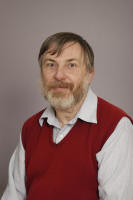 was
born in Jersey City, New Jersey on June 3, 1950. He obtained his B.S.
in Physics from Stevens Institute of Technology in 1972 and his Ph.D.
in Physics from the University of Texas at Austin in 1978. He then
worked for three years at the Applied Research Laboratories of the
University of Texas at Austin (ARL/UT) from 1978 to 1981, after which
he joined the scientific staff at the Woods Hole Oceanographic
Institution (WHOI). He has worked at WHOI since then, and currently
holds the position of Senior Scientist in the Applied Ocean Physics
and Engineering Department. His research specialty areas are ocean
acoustics and acoustical oceanography. He also greatly enjoys
occasional forays into physical oceanography, marine geology, and
marine biology. Dr. Lynch is a Fellow of the Acoustical Society of
America, a Fellow of IEEE, and was recently Editor-in-Chief of the
IEEE Journal of Oceanic Engineering. His hobbies include kempo karate,
classical piano, and amateur meteorology. was
born in Jersey City, New Jersey on June 3, 1950. He obtained his B.S.
in Physics from Stevens Institute of Technology in 1972 and his Ph.D.
in Physics from the University of Texas at Austin in 1978. He then
worked for three years at the Applied Research Laboratories of the
University of Texas at Austin (ARL/UT) from 1978 to 1981, after which
he joined the scientific staff at the Woods Hole Oceanographic
Institution (WHOI). He has worked at WHOI since then, and currently
holds the position of Senior Scientist in the Applied Ocean Physics
and Engineering Department. His research specialty areas are ocean
acoustics and acoustical oceanography. He also greatly enjoys
occasional forays into physical oceanography, marine geology, and
marine biology. Dr. Lynch is a Fellow of the Acoustical Society of
America, a Fellow of IEEE, and was recently Editor-in-Chief of the
IEEE Journal of Oceanic Engineering. His hobbies include kempo karate,
classical piano, and amateur meteorology.
|
Alan V. McCree
For contributions to low
bit-rate coding of speech signals
McCree bioAlan V. McCree
was born in Lower Hutt, New Zealand on April 20, 1960.
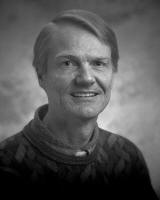 He received
the B.S. degree in electrical engineering (magna cum laude) in 1981
and the M.E.E. degree in 1982, both from Rice University, Houston, and
the Ph.D. degree in electrical engineering from the Georgia Institute
of Technology, Atlanta, in 1992. His thesis research under Professor
Thomas P. Barnwell III resulted in the development of the Mixed
Excitation Linear Predictive (MELP) speech coder. He received
the B.S. degree in electrical engineering (magna cum laude) in 1981
and the M.E.E. degree in 1982, both from Rice University, Houston, and
the Ph.D. degree in electrical engineering from the Georgia Institute
of Technology, Atlanta, in 1992. His thesis research under Professor
Thomas P. Barnwell III resulted in the development of the Mixed
Excitation Linear Predictive (MELP) speech coder.
Dr. McCree joined the Information Systems Technology
Group at MIT Lincoln Laboratory in 2004, where he conducts research in
speech processing. From 1993-2004, Dr. McCree worked at Texas
Instruments in Dallas, where he was a Distinguished Member of the
Technical Staff. His work at TI focused on speech coding, speech
synthesis, and noise suppression. He was a key contributor to
development of speech coders for digital answering machine, low-cost
synthesis, and wireless communication applications, including the 2.4
kb/s MELP NATO Standard. During 1992-1993, he was a consultant in
speech coding at AT&T Bell Laboratories, Murray Hill, NJ, where he
investigated new approaches for generating high quality speech at low
bit rates. He was a Senior Engineer at M/A-COM Linkabit, San Diego,
CA, from 1984 to 1988. There he developed algorithms for medium rate
speech coding, low rate speech coding, waveform coding of telephone
modem signals, and echo cancellation, and implemented algorithms in
real time on Texas Instruments digital signal processors. As a
geophysicist for Shell Oil, Houston, TX, from 1982 to 1984, he used
signal processing techniques to improve the interpretation of
electromagnetic data.
Dr. McCree has published 35 technical papers and
been awarded 21 U.S. patents. He is a Fellow of the IEEE, and has
served as member of the IEEE Signal Processing Society Speech
Technical Committee, Technical Chair for the the 2000 IEEE Workshop on
Speech Coding, and Technical Committee member for numerous workshops
and conferences. He has served on Ph.D. thesis committees at Chalmers
University, Tampere University, UCSB, and UCLA. His paper with Dr.
Barnwell, "A Mixed Excitation LPC Vocoder Model for Low Bit Rate
Speech Coding," received the IEEE Signal Processing Society
Outstanding Paper Award in 1997.
|
Andreas F. Molisch
For contributions to
radio-channel models for wireless communications systems
Andreas F. Molisch
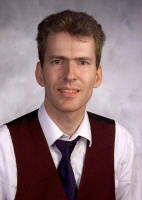 (S'89,
M'95, SM’00, F'05) received the Dipl. Ing., Dr. techn., and
habilitation degrees from the Technical University Vienna (Austria) in
1990, 1994, and 1999, respectively. From 1991 to 2000, he was with the
TU Vienna, becoming an associate professor there in 1999. From
2000-2002, he was with the Wireless Systems Research Department at
AT&T Laboratories Research in Middletown, NJ. Since then, he has been
a Senior Principal Member of Technical Staff with Mitsubishi Electric
Research Labs, Cambridge, MA. He is also professor and chairholder for
radio systems at Lund University, Sweden. (S'89,
M'95, SM’00, F'05) received the Dipl. Ing., Dr. techn., and
habilitation degrees from the Technical University Vienna (Austria) in
1990, 1994, and 1999, respectively. From 1991 to 2000, he was with the
TU Vienna, becoming an associate professor there in 1999. From
2000-2002, he was with the Wireless Systems Research Department at
AT&T Laboratories Research in Middletown, NJ. Since then, he has been
a Senior Principal Member of Technical Staff with Mitsubishi Electric
Research Labs, Cambridge, MA. He is also professor and chairholder for
radio systems at Lund University, Sweden.
Dr. Molisch's current research interests are the
measurement and modeling of mobile radio channels, MIMO systems, and
ultrawideband systems. He has authored, co-authored or edited two
books, seven book chapters, some 85 journal papers, and numerous
conference contributions. He is an editor of the IEEE Trans. Wireless
Comm., co-editor of a recent special issue on MIMO and smart antennas
in J. Wireless Comm. Mob. Comp., co-editor of an upcoming IEEE JSAC
special issue on UWB, and vice-chairman of the TPC of the 2005 spring
IEEE Vehicular Technology Conference. He is the chairman of the
COST273 and IEEE 802.15.4a channel modeling groups, vice chairman of
Commission C (signals and systems) of URSI (International Union of
Radio Scientists), and recipient of several awards.
|
Paul Nikolich
For leadership in enabling
ubiquitous broadband internet access and associated standards
Mr. Nikolich
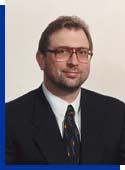 is
an industry consultant and investor working in the technology,
standards, intellectual property and venture investing fields since
September 2001. He serves on the technology advisory boards of
several companies developing emerging communications technologies and
products and provides strategic consulting services to senior
executives in the communications services and products industries.
Mr. Nikolich currently serves as Chairman of the IEEE 802 LAN/MAN
Standards Committee, a Standards Development organization that has
activities which spans more than 50 projects in wireline and wireless
communications and has over 1600 active members. He is a member of
the IEEE Standards Association Standards Board and of the New
Standards Committee. Prior to his current role, Mr. Nikolich
co-founded Broadband Access Systems, Inc. in February 1998 where he
was Vice President of Technology and Standards and responsible for
technology vision and intellectual property creation and management.
Prior to BAS, Mr. Nikolich has held a number of technical positions of
increasing responsibility at several networking & technology companies
beginning in 1978. He received a BS in Electrical Engineering and a
M.S. in Biomedical Engineering from Polytechnic University in
Brooklyn, N.Y. is
an industry consultant and investor working in the technology,
standards, intellectual property and venture investing fields since
September 2001. He serves on the technology advisory boards of
several companies developing emerging communications technologies and
products and provides strategic consulting services to senior
executives in the communications services and products industries.
Mr. Nikolich currently serves as Chairman of the IEEE 802 LAN/MAN
Standards Committee, a Standards Development organization that has
activities which spans more than 50 projects in wireline and wireless
communications and has over 1600 active members. He is a member of
the IEEE Standards Association Standards Board and of the New
Standards Committee. Prior to his current role, Mr. Nikolich
co-founded Broadband Access Systems, Inc. in February 1998 where he
was Vice President of Technology and Standards and responsible for
technology vision and intellectual property creation and management.
Prior to BAS, Mr. Nikolich has held a number of technical positions of
increasing responsibility at several networking & technology companies
beginning in 1978. He received a BS in Electrical Engineering and a
M.S. in Biomedical Engineering from Polytechnic University in
Brooklyn, N.Y.
|
Rosalind Wright Picard
For contributions to image
and video analysis and affective computing
Rosalind W. Picard
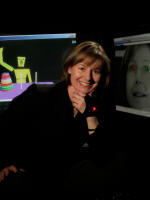 is
founder and director of the Affective Computing Research Group at the
Massachusetts Institute of Technology (MIT) Media Laboratory and is
co-director of Things That Think, the largest industrial research
consortium at the laboratory. She holds a Bachelors in Electrical
Engineering with highest honors from the Georgia Institute of
Technology, and Masters and Doctorate degrees, both in Electrical
Engineering and Computer Science, from MIT. Prior to completing her
doctorate at MIT, she was a Member of the Technical Staff at AT&T Bell
Laboratories where she designed VLSI chips for digital signal
processing and developed new methods of image compression and
analysis. She has been a member of the MIT faculty at the Media
Laboratory since 1991. is
founder and director of the Affective Computing Research Group at the
Massachusetts Institute of Technology (MIT) Media Laboratory and is
co-director of Things That Think, the largest industrial research
consortium at the laboratory. She holds a Bachelors in Electrical
Engineering with highest honors from the Georgia Institute of
Technology, and Masters and Doctorate degrees, both in Electrical
Engineering and Computer Science, from MIT. Prior to completing her
doctorate at MIT, she was a Member of the Technical Staff at AT&T Bell
Laboratories where she designed VLSI chips for digital signal
processing and developed new methods of image compression and
analysis. She has been a member of the MIT faculty at the Media
Laboratory since 1991.
The author of over a hundred peer-reviewed
scientific articles in multidimensional signal modeling, computer
vision, pattern recognition, machine learning, and human-computer
interaction, Picard is known internationally for pioneering research
in affective computing and, prior to that, for pioneering research in
content-based image and video retrieval. Her articles are highly
cited, and two have earned best paper prizes. Her award-winning book,
_Affective Computing_, (MIT Press, 1997) lays the groundwork for
giving machines the skills of emotional intelligence. She and her
students have invented a variety of new sensors, algorithms, and
systems for sensing, recognizing, and responding intelligently to
human affective information, with applications in human and machine
learning, health, and human-computer interaction. Picard lives in
Newton, MA with her husband and three sons.
|
John Anderson Plumer
For contributions to the
protection of aircraft from the effects of lightning
Biography and picture not available at press time.
J. Anderson Plumer
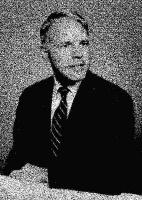 is
Founder and Chief Engineer of Lightning Technologies, Inc., a
corporation engaged in Research, Development, Design, Testing, and
Training aimed at development of protection solutions for advanced
aerospace and industrial facilities and systems against lightning and
other electrical hazards. Mr. Plumer has contributed to the design
and airworthiness certification of lightning protection for numerous
military and civilian airplanes and helicopters, and is developer and
lead Instructor for the company training courses, "Lightning
Protection of Aircraft" and "Lightning Protection of Avionics". He
has supported NTSB, US military services, and FAA on investigation of
aircraft accidents related to lightning, and he was the Lightning
Protection Team Leader for the CargoLifter (Germany) CL-160 transport
airship. He also is co-author of the book “Lightning Protection of
Aircraft” and the author of numerous technical papers, reports and
articles in the technology areas of lightning and electromagnetic
effects and protection design for aircraft. Mr. Plumer is a Fellow
of the Royal Aeronautical Society, and a member of SAE Subcommittee
AE2 and EUROCAE Working Group 31 on lightning protection for
aircraft. Mr. Plumer was recipient of the Admiral Luiz DeFlorez
Flight Safety Award in 1978, “For Advances and Developments in
Protection of Aircraft Electrical and Electronic Systems from the
Effects of Lightning,” and was presented the medal of the Office
Nationale d’Etudes et de Recherches Aerospatiales (ONERA) (France),
for leadership of international lightning protection standardization
activities for aircraft (1999). He is a chartered engineer in the
United Kingdom. is
Founder and Chief Engineer of Lightning Technologies, Inc., a
corporation engaged in Research, Development, Design, Testing, and
Training aimed at development of protection solutions for advanced
aerospace and industrial facilities and systems against lightning and
other electrical hazards. Mr. Plumer has contributed to the design
and airworthiness certification of lightning protection for numerous
military and civilian airplanes and helicopters, and is developer and
lead Instructor for the company training courses, "Lightning
Protection of Aircraft" and "Lightning Protection of Avionics". He
has supported NTSB, US military services, and FAA on investigation of
aircraft accidents related to lightning, and he was the Lightning
Protection Team Leader for the CargoLifter (Germany) CL-160 transport
airship. He also is co-author of the book “Lightning Protection of
Aircraft” and the author of numerous technical papers, reports and
articles in the technology areas of lightning and electromagnetic
effects and protection design for aircraft. Mr. Plumer is a Fellow
of the Royal Aeronautical Society, and a member of SAE Subcommittee
AE2 and EUROCAE Working Group 31 on lightning protection for
aircraft. Mr. Plumer was recipient of the Admiral Luiz DeFlorez
Flight Safety Award in 1978, “For Advances and Developments in
Protection of Aircraft Electrical and Electronic Systems from the
Effects of Lightning,” and was presented the medal of the Office
Nationale d’Etudes et de Recherches Aerospatiales (ONERA) (France),
for leadership of international lightning protection standardization
activities for aircraft (1999). He is a chartered engineer in the
United Kingdom.
|
Phillip Miles Smith
For contributions to
microwave high electron mobility transistors
Phillip M. Smith
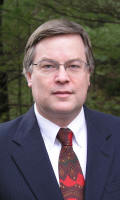 graduated
from Punahou School in Honolulu, Hawaii. He received BS, MS and PhD
degrees, all in Electrical Engineering, from Cornell University in
Ithaca, NY. In 1981 he joined the Electronics Laboratory (E-Lab) in
Syracuse, NY, remaining there for fifteen years, first as part of GE
(1981-1993), then Martin Marietta (1993-1995) and finally Lockheed
Martin (1995-1996). In 1996 he transferred to Sanders, a Lockheed
Martin Company, in Nashua, New Hampshire, which was subsequently
acquired by BAE Systems in 2000. Dr. Smith is currently Director of
Microwave Devices & Circuits. graduated
from Punahou School in Honolulu, Hawaii. He received BS, MS and PhD
degrees, all in Electrical Engineering, from Cornell University in
Ithaca, NY. In 1981 he joined the Electronics Laboratory (E-Lab) in
Syracuse, NY, remaining there for fifteen years, first as part of GE
(1981-1993), then Martin Marietta (1993-1995) and finally Lockheed
Martin (1995-1996). In 1996 he transferred to Sanders, a Lockheed
Martin Company, in Nashua, New Hampshire, which was subsequently
acquired by BAE Systems in 2000. Dr. Smith is currently Director of
Microwave Devices & Circuits.
Throughout his career, Dr. Smith has been actively
involved in the development of microwave semiconductor devices and
related circuitry, with particular emphasis on high electron mobility
transistors based on GaAs, InP and GaN material systems. He has
authored or co-authored 144 publications and presentations. Awards
include an Electronics Letters Premium for a 1986 paper reporting the
first transistor amplifier at 94 GHz and his selection as a Sanders
Engineering Fellow in 1996 for "long-standing technical excellence in
the field of solid-state microwave device and circuit technology". He
has served on Technical Program Committees for the International
Microwave Symposium (IMS), RFIC Symposium, IEDM and IPRM.
|
Aleksander M. Stankovic
For contributions to
modeling, analysis and control of transients in energy processing
systems
Aleksandar M. Stankovic obtained the Dipl. Ing.
degree from the University of
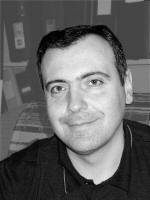 Belgrade, Yugoslavia in 1982, the M.S.
degree from the same institution in 1986, and the Ph.D. degree from
Massachusetts Institute of Technology in 1993, all in electrical
engineering. He has been with the Department of Electrical and Belgrade, Yugoslavia in 1982, the M.S.
degree from the same institution in 1986, and the Ph.D. degree from
Massachusetts Institute of Technology in 1993, all in electrical
engineering. He has been with the Department of Electrical and
Computer Engineering at Northeastern University,
Boston since 1993, presently as a Professor.
His research interests are in modeling, analysis,
estimation and control of power electronic converters, electric drives
and power systems. He serves as an Associate Editor for IEEE
Transactions on Power Systems and for IEEE Circuits and Systems
Magazine; he served IEEE Transactions on Control System Technology in
the same capacity from 1997 to 2001, covering power electronics and
drives. He has held visiting positions at the United Technologies
Research Center (sabbatical in 2000) and at L'Universite de Paris-Sud.
He is also a co-editor of book series on Power Systems and Power
Electronics for Springer.
|
James Ward
For leadership in
space-time adaptive processing for radar and sonar systems
Dr. James Ward_small.jpg) is Leader of the Advanced Sensor Techniques Group at MIT Lincoln
Laboratory, where he has worked since 1990. His areas of technical
expertise include signal processing for radar, sonar, and
communications systems, adaptive array and space-time adaptive
processing, detection and estimation theory, and systems analysis. Dr.
Ward has given tutorials on space-time adaptive processing and radar
adaptive array processing at several IEEE international radar and
phased array conferences. He has been an organizer and lecturer at
several Lincoln Laboratory short courses on radar systems. He received
the Bachelor of Electrical Engineering degree from the University of
Dayton, Dayton, OH, in 1985 and the MSEE and Ph.D. degrees from the
Ohio State University in 1987 and 1990, respectively. In 2001 he was
the recipient of the MIT Lincoln Laboratory Technical Excellence
Award, and in 2003 received the IEEE AESS Fred Nathanson Young Radar
Engineer Award for contributions to adaptive radar and sonar signal
processing. Dr. Ward is a newly elected Fellow of the IEEE.
is Leader of the Advanced Sensor Techniques Group at MIT Lincoln
Laboratory, where he has worked since 1990. His areas of technical
expertise include signal processing for radar, sonar, and
communications systems, adaptive array and space-time adaptive
processing, detection and estimation theory, and systems analysis. Dr.
Ward has given tutorials on space-time adaptive processing and radar
adaptive array processing at several IEEE international radar and
phased array conferences. He has been an organizer and lecturer at
several Lincoln Laboratory short courses on radar systems. He received
the Bachelor of Electrical Engineering degree from the University of
Dayton, Dayton, OH, in 1985 and the MSEE and Ph.D. degrees from the
Ohio State University in 1987 and 1990, respectively. In 2001 he was
the recipient of the MIT Lincoln Laboratory Technical Excellence
Award, and in 2003 received the IEEE AESS Fred Nathanson Young Radar
Engineer Award for contributions to adaptive radar and sonar signal
processing. Dr. Ward is a newly elected Fellow of the IEEE.
|
Albert J. Williams
For contributions to the
development of instrumentation for measuring oceanic processes
Albert J. Williams 3rd was born in Philadelphia on
October 17, 1940. He graduated
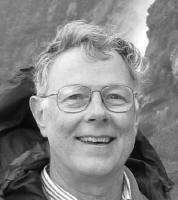 from
Germantown Friends School in 1958, from Swarthmore College with an AB
in physics in 1962, and from Johns Hopkins University with a Ph.D. in
physics in 1969. Sandy, as he has been called since birth, married
Isabelle Phillips in 1963 and they have a daughter, Helen Isabelle
born in 1981. He came to Woods Hole Oceanographic Institution as a
Postdoctoral Investigator in 1969 and was appointed Assistant
Scientist in 1970. He has been Associate Scientist, Senior Scientist,
Department Chair of Applied Ocean Physics and Engineering, and since
January 2003, Scientist Emeritus, all at Woods Hole Oceanographic
Institution. His research has used novel measurement techniques that
he developed to observe oceanic microstructure, turbulent mixing, and
benthic boundary layer processes. He observed salt fingers in the
Mediterranean outflow in 1972 and added an acoustic velocity sensor to
his free drifting shadowgraph probe to reveal shear at density
interfaces. He has extended his current measurement technique to a
modular current sensor, MAVS that is low cost and can measure
directional wave spectra as well as current and turbulence in the
boundary layer. This sensor is marketed by a company, Nobska
Development, Inc., that he founded in 1997. He enjoys travel, with
his wife, and sailing and gardening. He is past chairman of the
Current Measurement Technology Committee of the Oceanic Engineering
Society and recipient of the Distinguished Technical Achievement Award
for the year 2000. from
Germantown Friends School in 1958, from Swarthmore College with an AB
in physics in 1962, and from Johns Hopkins University with a Ph.D. in
physics in 1969. Sandy, as he has been called since birth, married
Isabelle Phillips in 1963 and they have a daughter, Helen Isabelle
born in 1981. He came to Woods Hole Oceanographic Institution as a
Postdoctoral Investigator in 1969 and was appointed Assistant
Scientist in 1970. He has been Associate Scientist, Senior Scientist,
Department Chair of Applied Ocean Physics and Engineering, and since
January 2003, Scientist Emeritus, all at Woods Hole Oceanographic
Institution. His research has used novel measurement techniques that
he developed to observe oceanic microstructure, turbulent mixing, and
benthic boundary layer processes. He observed salt fingers in the
Mediterranean outflow in 1972 and added an acoustic velocity sensor to
his free drifting shadowgraph probe to reveal shear at density
interfaces. He has extended his current measurement technique to a
modular current sensor, MAVS that is low cost and can measure
directional wave spectra as well as current and turbulence in the
boundary layer. This sensor is marketed by a company, Nobska
Development, Inc., that he founded in 1997. He enjoys travel, with
his wife, and sailing and gardening. He is past chairman of the
Current Measurement Technology Committee of the Oceanic Engineering
Society and recipient of the Distinguished Technical Achievement Award
for the year 2000.
|
Home | Conferences |